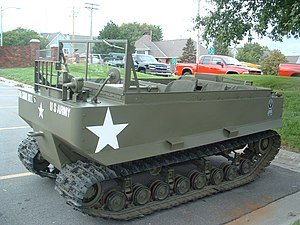M29 Weasel
| M29 Weasel | |
|---|---|
 |
|
| Type | Tracked vehicle |
| Place of origin | United States |
| Specifications | |
| Weight | 3,800 lb (1,700 kg) dry |
| Length | 10 ft 6 in (3.20 m) |
| Width | 5 ft (1.5 m) later 5 ft 6 in (1.68 m) |
| Height | 4 ft 3 in (1.30 m) 5 ft 11 in (1.80 m) to top of windscreen |
| Crew | 4 |
|
|
|
| Engine |
Studebaker Model 6-170 Champion 6-cylinder 70 hp (52 kW) |
| Suspension | Tracked |
|
Operational
range |
165 mi (266 km) |
| Speed | 36 mph (58 km/h) |
The M29 Weasel was a World War II tracked vehicle, built by Studebaker, designed for operation in snow.
The idea for the Weasel came from the work of British inventor Geoffrey Pyke in support of his proposals to attack Axis forces and industrial installations in Norway. Pyke's plan to hamper the German atomic weapons development became Project Plough for which he proposed a fast light mechanised device that would transport small groups of commando troops of the 1st Special Service Force across snow. In active service in Europe, Weasels were used to supply frontline troops over difficult ground when wheeled vehicles were immobilised.
The first 2,103 vehicles had 15 in (380 mm) tracks, a later version had 20 in (510 mm) tracks. The M29 was amphibious, but with a very low freeboard; the M29C Water Weasel was the amphibious version, with buoyancy cells in the bow and stern as well as twin rudders. M29C could not operate in other than inland waterway conditions, so its use in surf or rough water was very limited but was used in the Pacific theatre.
Evidence exists for M29s being brought to the Meiringen railway station in November 1946, to support the U.S. Army's attempt to rescue the twelve individuals from the scene of the 1946 C-53 Skytrooper crash on the Gauli Glacier. The Weasels were planned to be used for a ground rescue, climbing up the Gauli Glacier. A pair of Swiss Flugwaffe-flown Fieseler Storch STOL aircraft were able to effect the rescue solely by air, before the Weasels were needed.
M29 Weasel with various slogans written on the front.
M29 Weasel in Winter 1944.
M29C Weasel in Arctic finish in a display at the U.S. Army Transportation Museum
M29 Weasel knocked out in combat in Okinawa.
M29 Weasel of First Marine Division communication section in Korean war.
The Weasel idea was introduced in 1942, when the First Special Services Force needed transportation into Norway to knock out strategic power plants. The vehicle needed to move quickly and easily through the winter snows of Norway. It needed to be air transportable and be able to withstand the effects of being dropped by parachute and would also be able to carry arms, explosives and minimal resupply stocks.
...
Wikipedia
